
Want to know the true value of your Gibson guitar? The serial number can help you find the production date, country, and even the factory where your instrument was made. We have collected extensive data on Gibson serial numbers to tell the history of your guitar.
Gibson is known for having the most duplicated serial numbers and has used different numbering systems since 1900, making it challenging to determine the production year based only on the serial number. Between 1902 and 1976, Gibson instruments were assigned a serial number, a Factory Order Number (FON), or both. However, this practice was not always consistent, resulting in some instruments without any serial number identification.
Table of Contents
See also
How To Find Gibson Serial Number?
You can find Gibson serial number stamped or punched on the back of the headstock, inside the sound hole on acoustic guitars, or the “F” hole on semi-acoustic instruments. Acoustic models have been produced in Bozeman, Montana since 1989.
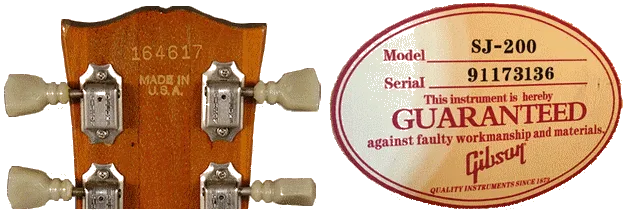
Gibson Vintage Serial Number 1935-1941
The first Gibson serial number – Factory Order Number (FON) consists of a batch number of usually 4 digits, followed by one letter (sometimes prefixed by a space) followed by one or two digits (ranking).
• 1935-1937: Letter between the batch number and the order number (e.g., 0123 A5)
• 1938-1941: Two or three letters before batch number. The first letter is the year. If there is a second character following it is the code for the type of the instrument (G = Gibson, K = Kalamazoo, W Recording King (Montgomery Wards)).
If follows there is a third letter “E,” which stands for Electric.
• Exceptions: Some high-end models and lap steels from 1939-1940 have added the letter A, to the prefixes D, E, or F.
Gibson Serial Number (FON) CHART – 1935-1941
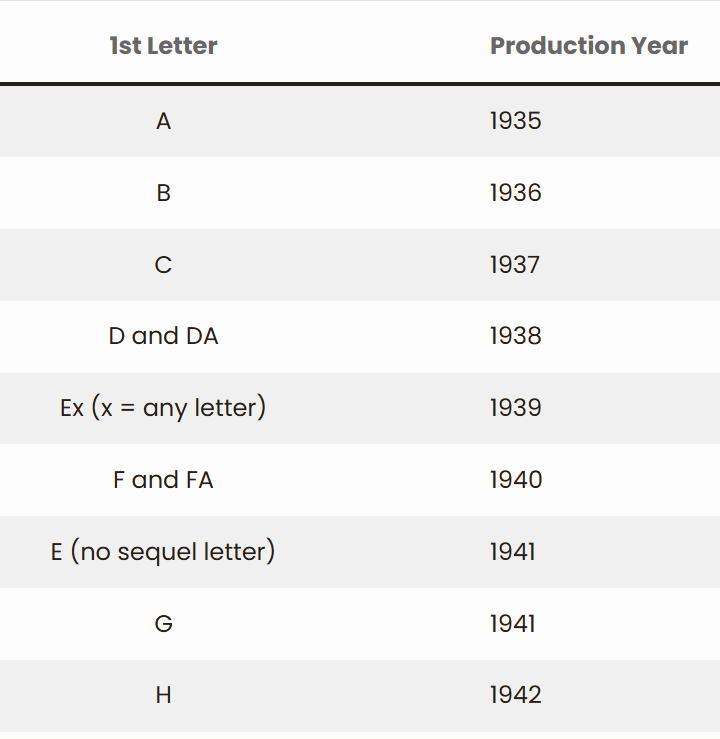
Gibson Serial Code 1952-1961 – Factory Order Number
The letter preceding the serial number in the FON, and indicates the year of production. The serial number is the first 4 digits of the FON, followed by a one or 2-digit number. This letter must be before the FON serial number (e.g., Y1234 23).
This was done on archtop models from 1952 to 1961 and is stamped on the inside of the F-hole.
On flat tops, it was stamped on the neck block.
Gibson FON Number CHART – 1952-1961
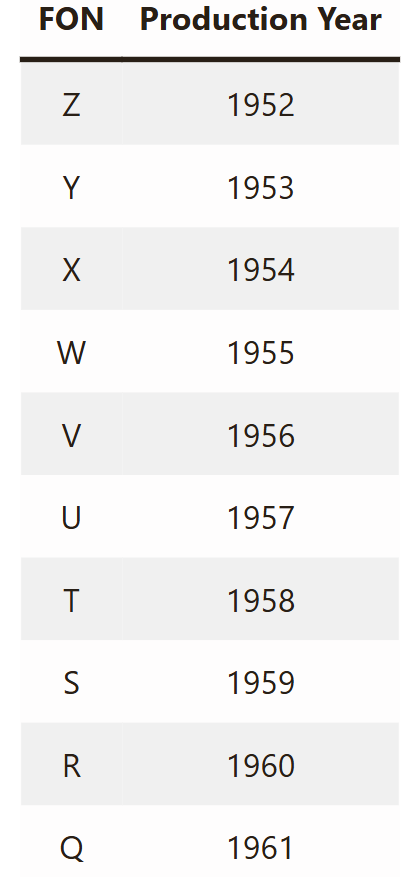
Gibson USA Serial Number 1952-1961
Gibson’s solid body guitars were released in 1952. Gibson did not use serial numbers at that time but started in 1953.
The first digit of the serial number is the last digit of the year. If the stamped numeral consists of 5 digits, there is a space between the first and second digits (a separation between the last digit of the year and the actual serial number).
If it concerns a 6-digit serial number, there is no space, because the highest 4-digit number (9999) has been exceeded and the space therefore fills up. This was the case in the years 1955, 1956, 1959 and 1960.
In 1955, Gibson forgot to reset the series of serial numbers to 0001.
So they had only set the year from 4 to 5. For this reason, the series of 4-digit serials was exceeded after 9999.
Hence 5 digits and no space between the year (5) and the serial number (after 5 9999 came 510 000).
The production was high in 1956 because 6 9999 was exceeded. Also in 1959 and 1960, there was a high production, 9 9999 is exceeded to 932 000 or higher.
Thus, from the production in 1959, a 1, 2, or 3 may be the second digit.
Gibson stopped the stamped serials at the end of 1960, although a few instruments were made in 1961 with a “1” as a prefix. Some lapsteels and Les Paul’s from 1961 have such a serial number.
Another exception to the above rules is in the fall of 1958 when some Les Paul Junior and Special had a 4-digit serial number.
Gibson Serial Number Chart – 1952-1961
| 1st Letter | Production Year |
|---|---|
| None | 1952 |
| 3 | 1953 |
| 4 | 1954 |
| 5 | 1955 |
| 6 | 1956 |
| 7 | 1957 |
| 8 (at the end of 1958, a lot of LP Juniors/Specials had a 4-digit serial number without a prior annual digit) | 1958 |
| 9 | 1959 |
| 0 | 1960 |
| 1 (rare) | 1961 |
5 and 6-Digit Gibson Serial Numbers 1961-1970
Gibson started in 1961 with a new series numbering system. They wanted to apply a more structured series of sequences, but in practice, the opposite happened. Numerals were reused during this period, and in many cases, the numerals were not strictly applied for successive years.
For all models, the serial number is stamped on the back of the headstock. Gibson’s headstock serial was duplicated from 1963 to 1969.
From this period the 5-digit and 6-digit serial numbers are easy to confuse and give an incorrect year.
Gibson headstock Serial number Chart – 1961-1972
| 1st Letter | Production Year |
|---|---|
| 0100 – 42440 | 1961 |
| 42441 – 61180 | 1962 |
| 61450 – 64222 | 1963 |
| 64240 – 71040 | 1964 |
| 71041 – 96600 | 1962 (some 1963 and 1964) |
| 96601 – 99999 | 1963 |
| 000001 – 099999 | 1967 (all 6-digit numerals starting with 0. are 1967) |
| 100000 – 106099 | 1963 or 1967 |
| 106100 – 106899 | 1963 |
| 109000 – 109999 | 1963 or 1967 |
| 110000 – 111549 | 1963 |
| 111550 – 115799 | 1963 or 1967 |
| 115800 – 118299 | 1963 |
| 118300 – 120999 | 1963 or 1967 |
| 121000 – 139999 | 1963 |
| 140000 – 140100 | 1963 or 1967 |
| 140101 – 144304 | 1963 |
| 144305 – 144380 | 1964 |
| 144381 – 149864 | 1963 |
| 149865 – 149891 | 1964 |
| 149892 – 152989 | 1963 |
| 152990 – 174222 | 1964 |
| 174223 – 176643 | 1964 or 1965 |
| 176644 – 250335 | 1964 |
| 250336 – 305983 | 1965 |
| 306000 – 310999 | 1965 or 1967 |
| 311000 – 320149 | 1965 |
| 320150 – 320699 | 1967 |
| 320700 – 329179 | 1965 |
| 329180 – 330199 | 1965 or 1967 |
| 330200 – 332240 | 1965, 1967 or 1968 |
| 332241 – 348092 | 1965 |
| 348093 – 349100 | 1966 |
| 349121 – 368638 | 1965 |
| 368640 – 369890 | 1966 |
| 370000 – 370999 | 1967 |
| 380000 – 385309 | 1966 |
| 390000 – 390998 | 1967 |
| 400001 – 406666 | 1966 |
| 406667 – 409670 | 1966 – 1968 |
| 409671 – 410900 | 1966 |
| 410901 – 419999 | not known |
| 420000 – 429193 | 1966 |
| 500000 – 500999 | 1965, 1966, 1968 or 1969 |
| 501009 – 501600 | 1965 |
| 501601 – 501702 | 1968 |
| 501703 – 502706 | 1965 or 1968 |
| 503010 – 503109 | 1968 |
| 503405 – 520955 | 1965 or 1968 |
| 520956 – 530056 | 1968 |
| 530061 – 530850 | 1966, 1968, or 1969 |
| 530851 – 530993 | 1968 or 1969 |
| 530994 – 539999 | 1969 |
| 540000 – 540795 | 1966 or 1969 |
| 540796 – 545009 | 1969 |
| 555000 – 557999 | 1966 |
| 558000 – 567400 | 1969 |
| 570087 – 570643 | 1966 |
| 570645 – 570755 | 1966 or 1967 |
| 570857 – 570964 | 1966 |
| 580000 – 580080 | 1969 |
| 580086 – 580999 | 1966, 1967 or 1969 |
| 600000 – 600998 | 1966, 1967, or 1968 (low-end models) |
| 600000 – 606090 | 1969 (high-end models) |
| 700000 – 700803 | 1966, 1967 or 1969 |
| 750000 – 750999 | 1968 or 1969 |
| 800000 – 800999 | 1966, 1967, 1968 or 1969 |
| 801000 – 812838 | 1966 or 1969 |
| 812900 – 819999 | 1969 |
| 820000 – 820087 | 1966 or 1969 |
| 820088 – 823830 | 1966 |
| 824000 – 824999 | 1969 |
| 828002 – 847488 | 1966 or 1969 |
| 847499 – 858999 | 1966 or 1969 |
| 859001 – 891999 | 1967 |
| 892000 – 896999 | 1968 |
| 897000 – 898999 | 1967 or 1969 |
| 899000 – 899999 | 1968 |
| 900000 – 909999 | 1970 |
| 910000 – 999999 | 1968 |
6-Digit Gibson Serial Number 1970-1975
From 1970 to 1975 the 6-digit Gibson serial numbers were randomly created. In a random order, serials were stamped on the back of the headstock. With some instruments preceded by a letter.
In 1970 the orange labels inside the body of acoustic guitars were replaced by white with orange rectangular labels.

The electric models were provided with a rectangular with a black and purple triangle.
From 1970 “MADE IN USA” was also stamped on the back of the headstock. Some instruments from the fifties also had such a stamp.
After production continued by Gibson’s new company Norlin (1969-1986), the same confusing 6-digit serial system from the 1960s continued until 1975.
This means that instruments with the same Gibson serial number were produced either in the 1960s or 1970s.
Guitars got six digits in random order, and in some cases, they were preceded by a letter that did not seem to have meaning.
Note that Gibson serials between 1970 and 1975 may be a repeat of the serial numbers from 1964 and 1965. In 1970 some 6-digit serials had the letter “A” as a suffix.
The table below shows the years to which the serial numbers can relate.
Gibson headstock Serial Number chart – 1970-1975
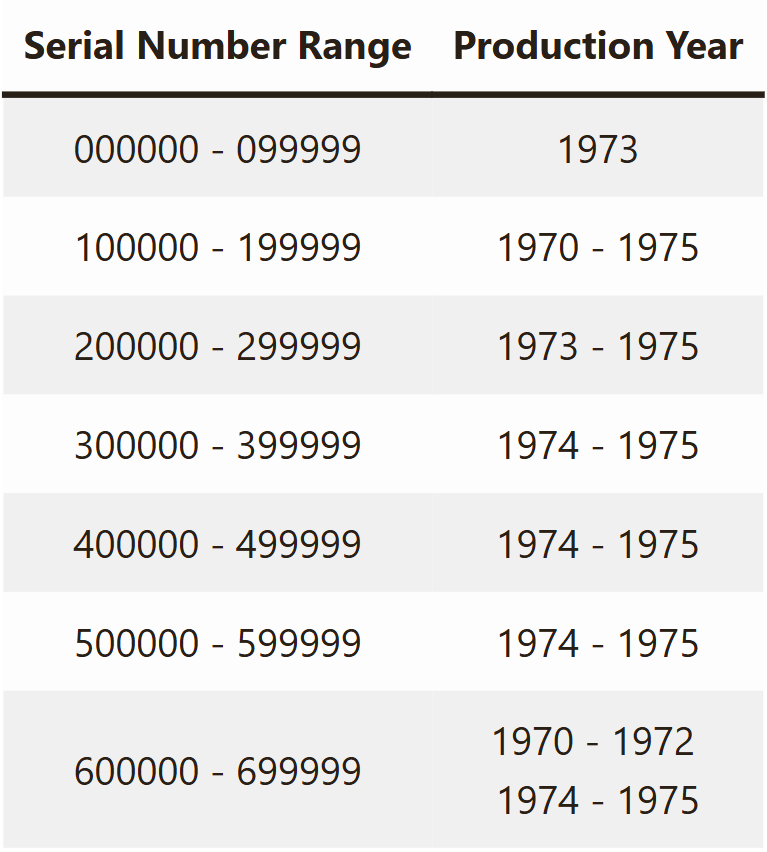
Gibson Limited Edition Serial Number
The limited editions from 1975 to 1977 have a gold-colored serial number and imprint “Made in USA.” These serials are preceded by 2 digits. 99 = 1975, 00 = 1976 and 06 = 1977.
8-Digit Gibson Serial Number (Since 1977)
Gibson’s most sustainable numbering system was launched in 1977, an 8-digit serial number. The first and fifth digits represented Gibson’s year of manufacture. The three intervening digits, the day of that year. The digits 6 to 8 indicated the sequence numeral.
Example: 80923015
80923015 is 1983, day 092 (day 92 of 1983 is 2 April), production number 015.
After the opening of the new factory in Nashville, production was also included in the serial numbers. 001 to 499 appeared on instruments built in Kalamazoo, 500 to 999 built in Nashville.
Even after the Kalamazoo plant closed in 1984, this process continued until 1989 in Nashville.
9-Digit Gibson Serial Number (Since 2005)
In July 2005 this 8-digit system was updated by adding 1 digit. The first 6 digits are the batch number, and the last 3 digits are the sequence number of the batch. The sequence numeral runs from 500 to 699.
Example: 113142030 is the 30th instrument from batch 4 of May 11, 2014.
When 699 is reached the batch number is incremented by 1, and the sequence number is reset to 500.
This system was changed again at the beginning of 2014. The day and batch number were no longer included in the serial number. The Gibson serial number now consists of 9 digits, the first 2 of which indicate the year and the next 7 digits the sequence numeral.
160001234 is the production year 2016 with sequence number 0001234.
Gibson closed the Memphis plant in April 2019. The production of “USA-made” solid body guitars is now only produced in Nashville.
In 2019, Gibson USA returned to its post-2005 serial number format, which follows the YDDDYRRRR pattern:
- YY: Represents the production year.
- DDD: The day of the year (from 001 to 365).
- RRRR: Indicates the factory ranking for that specific day, starting with 0001.
Gibson Custom Guitars Serial Numbers
Gibson Custom guitars have a detailed serial number system that varies by model and production year. Here’s a breakdown of the different formats used for various Custom serials:
1952-1960 Reissues (Les Paul, Explorer, Flying V, Futura)
Gibson Custom 1952–1960 Les Paul, Explorer, Flying V, and Futura, which have been reissued since late 1992, are characterized by a specific serial number format.
Format: M YRRR or MYRRRR
- M: This represents the model year being reissued.
- Y: This indicates the production year of the guitar.
- RRR(R): This part shows the guitar’s place in production for that year. It’s important to note that this number encompasses all models released for a specific reissue year. For instance, a 1958 Reissue serial number could account for both the ’58 Reissue LP Standard and the ’58 Explorer.
Example: 6 1234
In this example, the serial number indicates that this is the 234th 1956 reissue model produced in 2001.
1961-1969 Reissues (Firebird, Les Paul, and SG)
Gibson Custom serials for 1952–1960 Firebird, Les Paul, and SG models, which have been reissued since 1997, followed the format YYRRRM:
- YY: The production year of the guitar.
- RRR(R): Indicates the guitar’s place in production for that year.
- M: The model being reissued.
Reissue Model Codes:
- 1 = SG Custom and Special
- 2 = SG Standard
- 3 = 1963 Firebird 1
- 4 = 1964 Firebird III
- 5 = 1965 Firebird V & VII
- 8 = 1968 Les Paul Custom
Example:
- 0600303 indicates the 30th 1963 Firebird 1 reissue produced in 2006.
Historic ES Models (since 1995)
Starting in 1995, the serial numbers for Historic ES model reissues follow the format (A or B)-MYRRR:
- M: The model (and year being reissued.)
- Y: The production year.
- RRR: The guitar’s place in the production sequence for that year.
Reissue Model Codes:
- 2 = ES-295
- 3 = 1963 ES-335 (block inlays)
- 4 = ES-330
- 5 = ES-345
- 9 with an “A” prefix = 1959 ES-335 (dot inlays)
- 9 with a “B” prefix = ES-355
Example:
- B-59010 indicates the 10th ES-355 reissue produced in 1999.
Carved Top Models (Serial Number on Orange Label)
For Carved Top models, the serial numbers follow the format YDDDYRRR:
- YY: The production year.
- DDD: The day of the year (from 001 to 365).
- RRR: Indicates the guitar’s place in the sequence of carved tops produced on that day.
Important Note:
- Starting in the year 2000, the first digit of the serial number will always be a “2.”
Example:
- 20123015: This is the 15th carved top produced on the 123rd day of 2020.
Custom Shop Regular Production Models
For Custom Shop regular production models, the serial numbers follow the format CSYRRRR:
- CS: Stands for “Custom Shop.”
- Y: Indicates the production year.
- RRRR: Represents the guitar’s place in the sequence of production.
Example:
- CS20432: This is the 432nd regular production Custom Shop model produced in 2002.
Custom Shop Signature Models
For CS Signature Models, the serial numbers vary depending on the specific model. Below are some notable examples:
Ace Frehley Les Paul: This model was produced in a limited run in 1997 and is numbered as “ACE xxx.” Note: The discontinued Gibson USA Ace Frehley Signature Les Paul features a standard 8-digit serial number.
Andy Summers ES-335: This is a limited edition of 50 units, numbered as “AS xxxx.”
Dickey Betts ’57 Goldtop Les Paul: This limited edition consists of 114 units, numbered as “DB xxx.”
Dickey Betts ’57 Redtop Les Paul: This model is numbered as “DBR xxx.”
Gary Rossington Les Paul: This model has a limited edition of 250 units and is numbered as “GR xxx.”
Gary Rossington SG: This is also a limited edition of 250 units, numbered as “13xxx.”
Jimmy Page Les Paul:
- The first 25 aged models are hand-numbered from 1 to 25 and signed by Jimmy Page, with no additional number on these models.
- There is a limited run of 150 aged models, numbered as “PAGE xxx.”
- An unlimited series of Custom Authentic models is numbered as “JPP xxx.”
Note: The discontinued Gibson USA Jimmy Page Signature Les Paul uses a standard 8-digit serial number.
Joe Perry Les Paul:
- The Joe Perry Signature Les Paul from 1996 (in transparent black) is numbered as “JPxxx.”
- The Boneyard LP features Pilot Run models with an inked number and handwritten “Pilot Run.” The regular production version is numbered as “BONE xxx.” Note: The discontinued Gibson USA Joe Perry Signature Les Paul has a standard 8-digit serial number.
Johnny A.: This model is numbered as “JA xxx.”
Pete Townshend LP Deluxe: This limited run of 75 units is numbered as “PETE xxx.”
Peter Frampton Les Paul:
- The PF LP Custom is numbered as “PF xxx.”
- The PF LP Special is numbered as “PFYxxx,” where Y indicates the year of production.
Slash Les Paul:
- The limited edition model from 1997 (cranberry finish) is numbered as “SL xxx.”
- The regular production model from 2004 is also numbered as “SL xxx.” Note: The discontinued Epiphone Slash Les Paul has a standard Epiphone serial number.
Tony Iommi SG: This model is numbered as “TI xxx.”
Zakk Wylde Les Paul:
- The Bullseye and the rare “Rough Top” versions are numbered as “ZW xxx.”
- The camo version is numbered as “ZPW xxx.”
Dating Gibson by Potentiometers
If you can not find your Gibson serial number, you can approximate the age of a semi/electric guitar based on the potentiometers. The code on potentiometers gives information about the manufacturer and the year and week when it is made.
Potentiometer suppliers to Gibson included IRC, CTS, CentraLab, and CGE (with the Gibson logo).
IRC and CGE potentiometers were used in the 1950’s. Due to the fragile design of the CGE potentiometers, which wore out quickly, Gibson switched to potentiometers from CTS, and then CentraLab.
Gibson Headstock Logo Dating
The Gibson logo can also indicate the year of construction (approximately).
The first logo (1902-1920) on Gibson guitars was in italic typeface, inlaid with pearl. Some specimens from 1903 to 1907 were not oblique or had no logo at all.
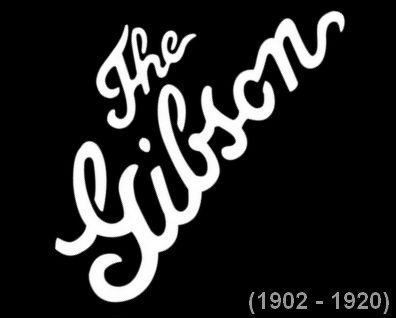
During the period from the end of the 1920s to 1933, the logo was no longer placed obliquely. From some flattop guitars from this era the word “The” was omitted from the logo.
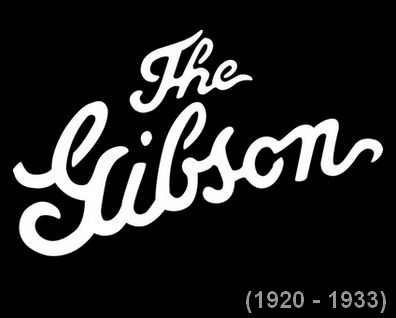
From the end of 1933 to 1943, Gibson had omitted the “The” of all their logos. The original thin letters were replaced after 1933 by a thicker font.

From 1943 to 1947 the logo was printed in thick gold, also called the banner logo. Some models, such as the LG-2 and the L-50s, have a real banner in the middle of the headstock with the text “Only a Gibson Is Good Enough.”

The block logo made its appearance after World War II and is still the face of Gibson to this day. Between 1968 and 1981 the dot on the “i” was omitted on some guitars. Most models get a dot on the “i” again in 1972, the rest follows from 1981.

Dating Gibson Banjos
Gibson banjos, produced from 1988 to the present, follow various serial number formats depending on the model. Here’s a breakdown of the most notable models and their respective serial number systems:
Earl Scruggs Models:
- Standard: Uses a simple sequential production number starting at 001.
- ’49 Classic: Follows the format YY-RR, where YY represents the year of manufacture and RR is the ranking number, beginning from 01.
- Golden Deluxe: Shares the same YY-RR format as the ’49 Classic.
- Flint Hill Special: The serial number format is FH-YY-RR, with FH indicating the model, YY for the year, and RR as the ranking number, starting at 01.
- Special: Uses the ES-YY-RR format, where ES stands for Earl Scruggs, YY represents the year, and RR is the ranking number.
Style 250:
- The format is 250-TT-RR, where 250 represents the model, TT indicates the year of manufacture, and RR is the ranking number, starting from 01.
Granada:
- Follows the format YY-MM-RR, with YY for the year, MM for the month, and RR for the ranking number.
RB Models:
- These use a simple sequential production number, typically in the format RB###.
Other Models:
- Most other models follow the format S(S)-YYMM-RR, where S(S) indicates the style, YYMM represents the year and month of manufacture, and RR is the ranking number.
Dating Gibson Goldtone Amps
Gibson Goldtone amps feature a clear serial number system that includes the product code, production number, and the quarter and year of manufacture. The format is as follows:
Example: G-12/345/499
- The “G” denotes Gibson, which is sometimes confused with a “6”.
- The first number (12) indicates the product code.
- The second number (345) represents the production number.
- The final set of numbers (499) shows that this amp was made in the 4th quarter of 1999.
This system allows for easy identification of the amp’s production details.